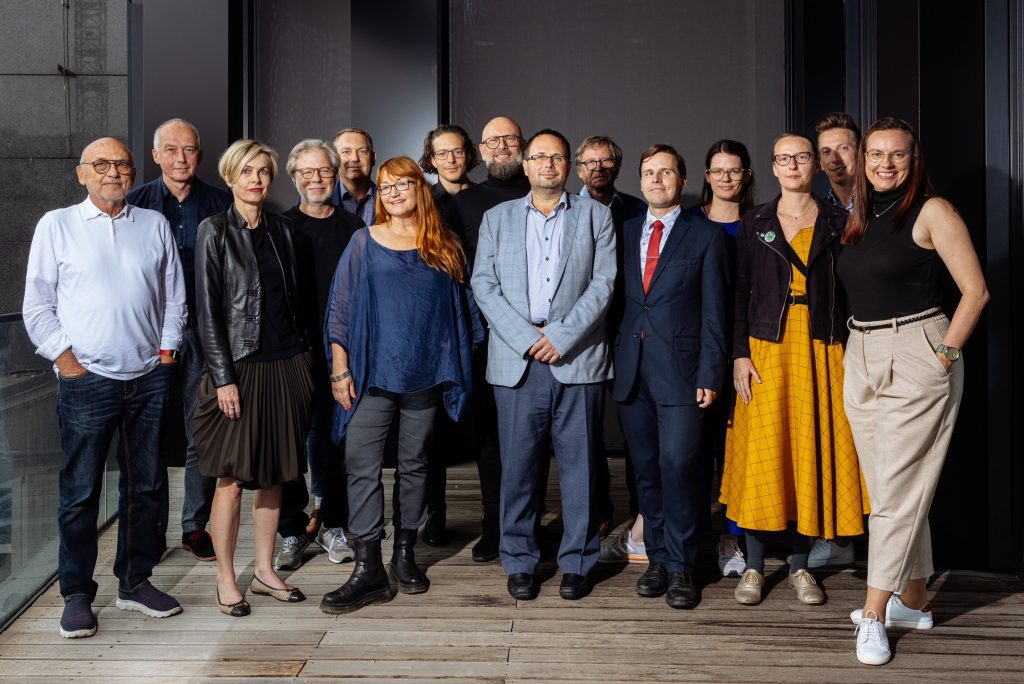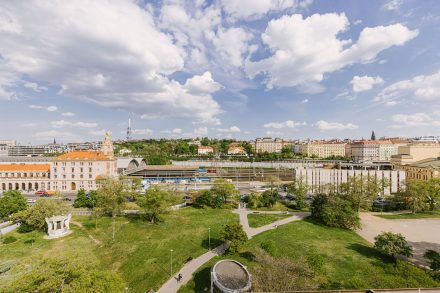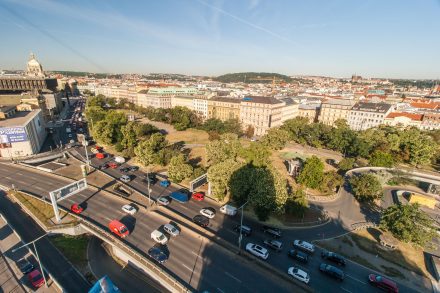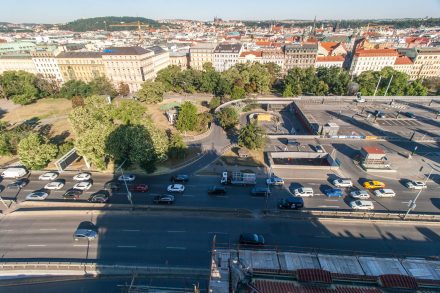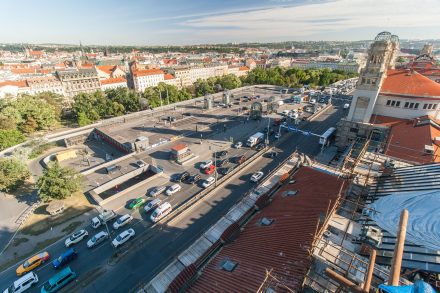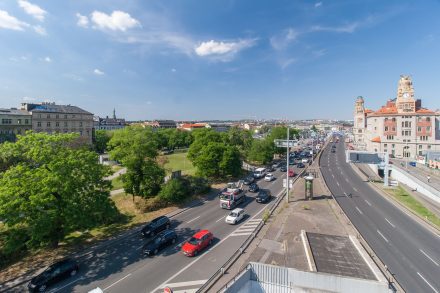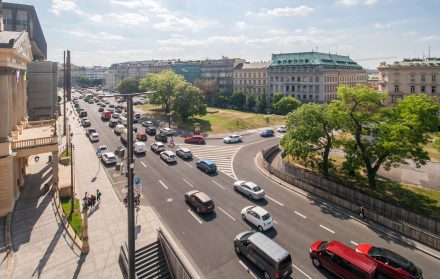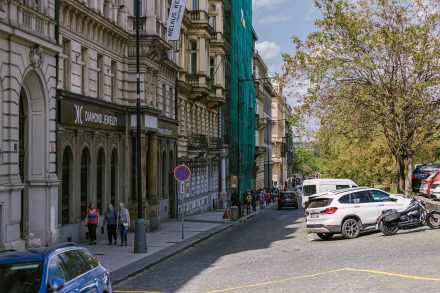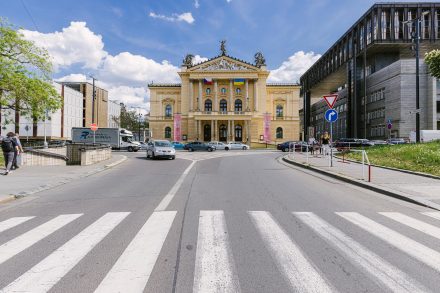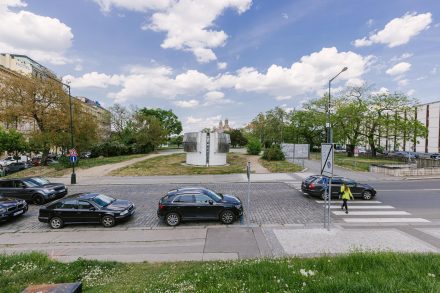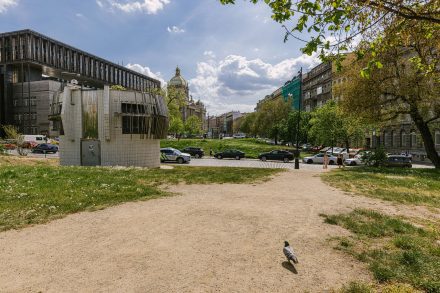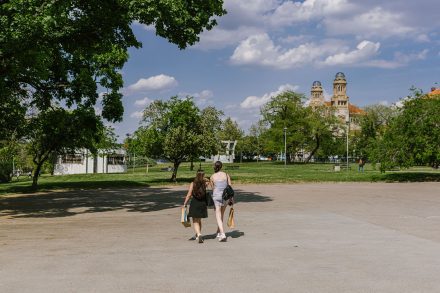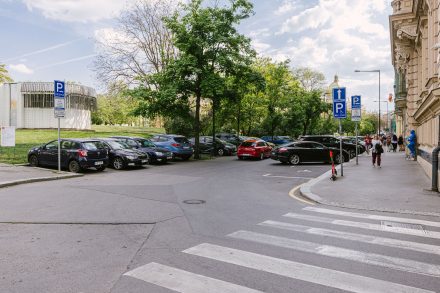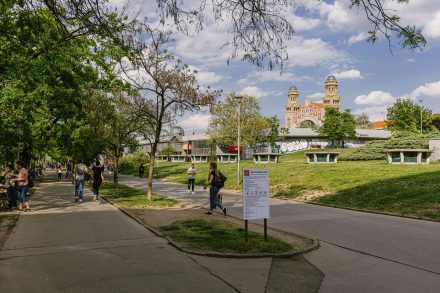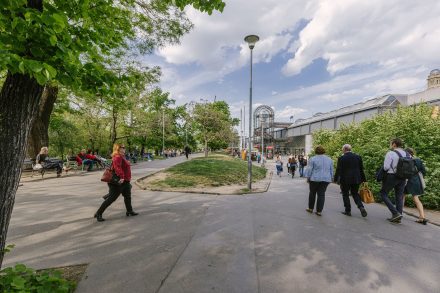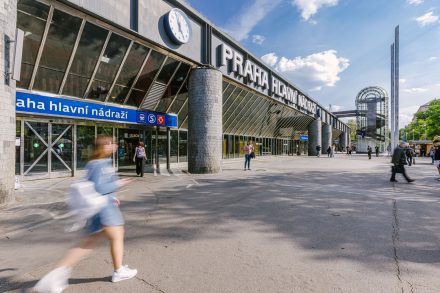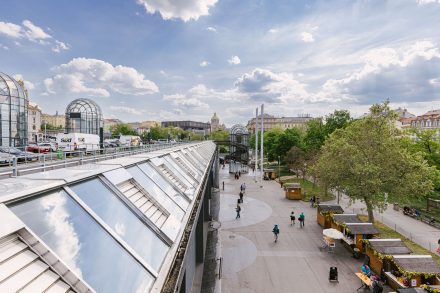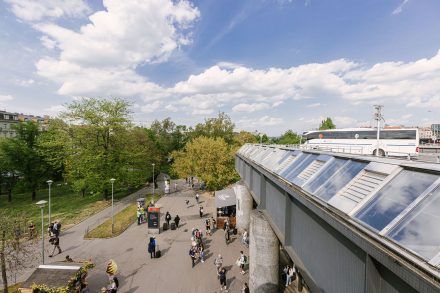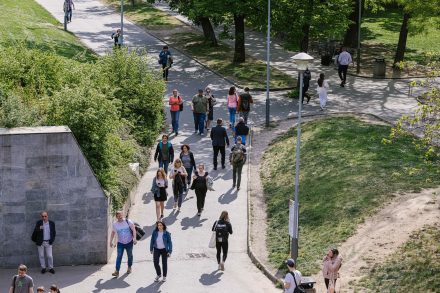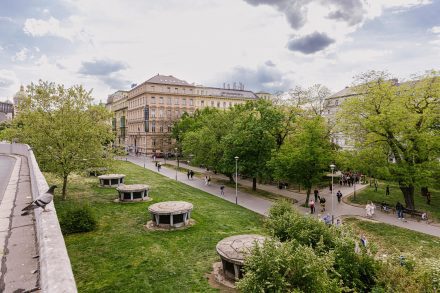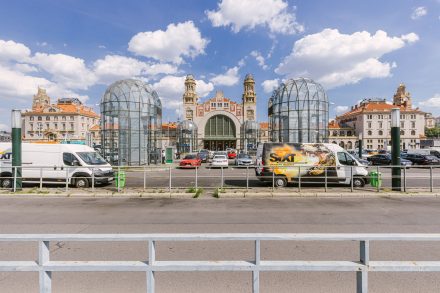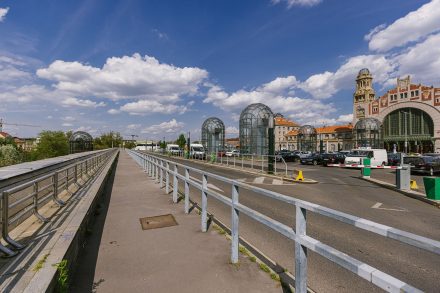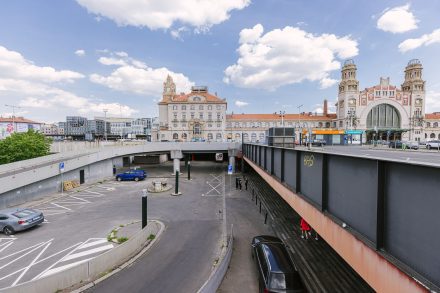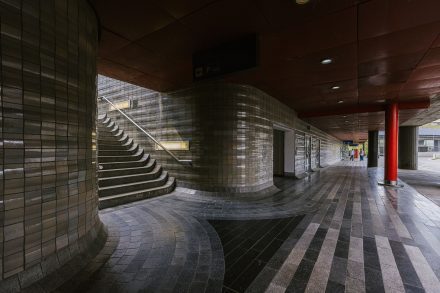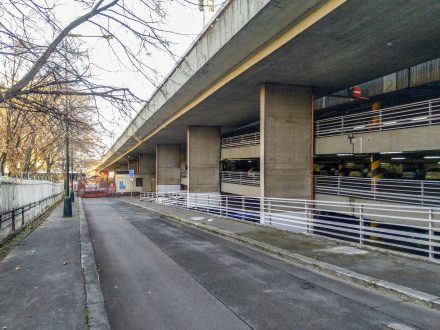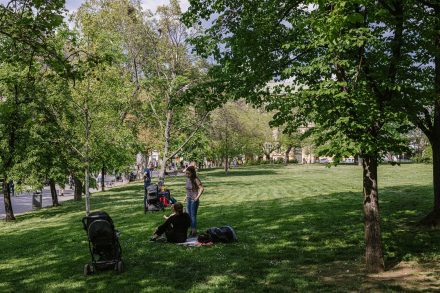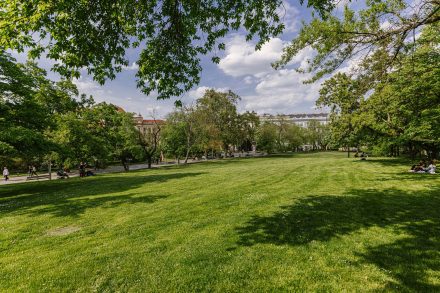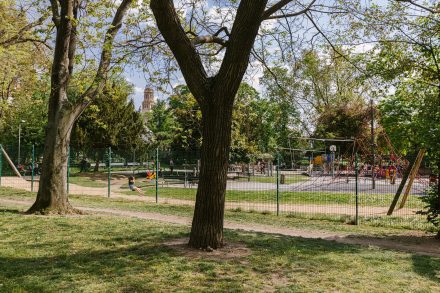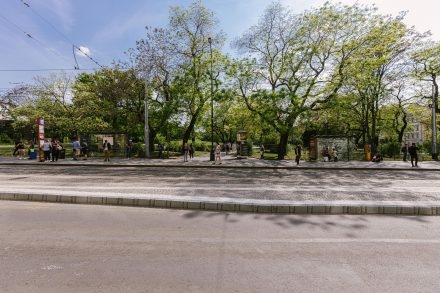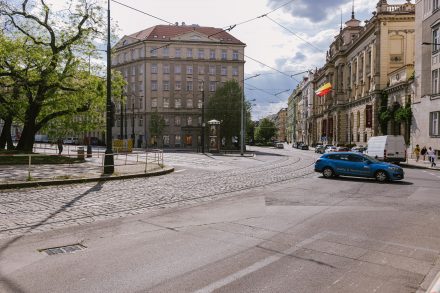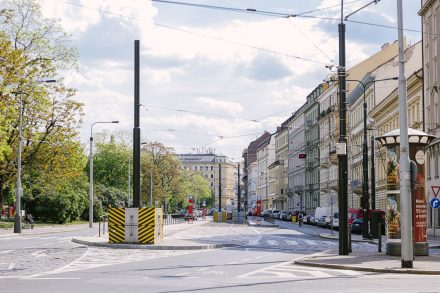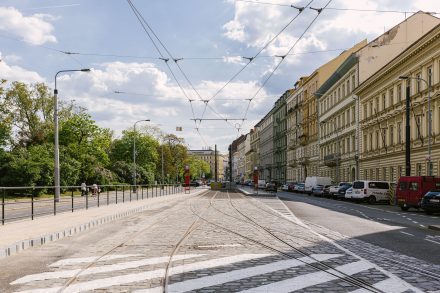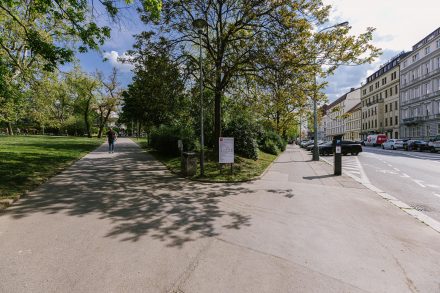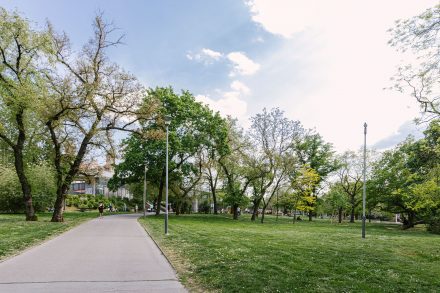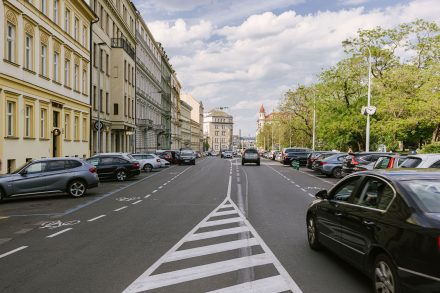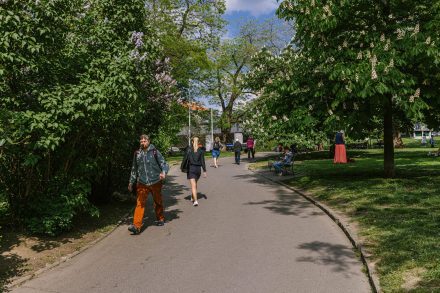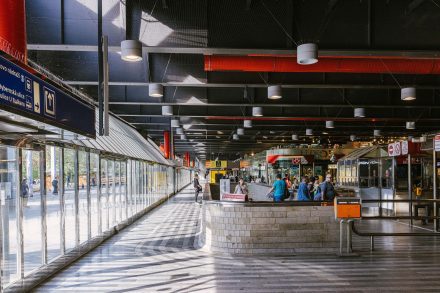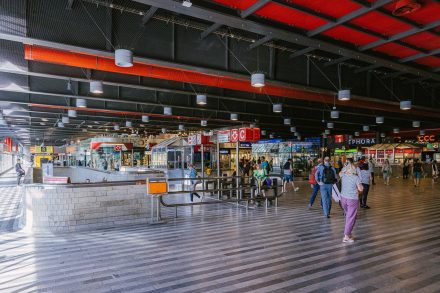Press room
Reaction to the current listing of the New Check-in Hall (NOH) of the main railway station in Prague as a cultural monument in the NPÚ catalogue
The Prague City Council, together with the Railway Administration and the Transport Company of the Capital City of Prague, will be responsible for the construction of the railway station. The Prague City Council, together with the Railways of Prague, as the commissioners of the Nový Hlavák Competition Dialogue, consider it necessary to comment on the current situation.
The registration of the main station hall in the catalogue of cultural monuments of the National Institute of Culture came unexpectedly literally overnight and is a surprise for us. However, the listing is based on invalid justification and has no legal basis. The hasty and unsubstantiated action of the National Heritage Institute is not only substandard, but also gives the impression of expediency. Our goal at this point is to get a clear and final opinion from the authorities, with which the winning team can continue working on the architectural study. We are therefore ready to discuss the situation further with the National Institute of Architecture.
During the creation of the tender documentation for the competitive dialogue, we consulted the situation with the National Heritage Institute and the Department of Heritage Care of the Prague City Hall. Representatives of the National Heritage Institute confirmed to us at a meeting before the announcement of the Tender Dialogue that the NOH is not a registered monument. In addition, the Institute had a draft of the competition assignment, which the conservationists did not dispute in any way, and based on the discussion it was added that the participants in the competitive dialogue were expected to follow a sensitive approach to the reconstruction of buildings in the Prague Conservation Area. This makes today's development all the more striking.
Only at the very final stage of the competitive dialogue did the Ministry of Culture tell us that it considered the NOH a cultural monument, referring to the opinion of the Railway Authority. The latter first referred to the NOH as an extension of the Fanta building and then corrected its opinion after completing the documents. This corrected opinion (attached hereto) now shows that the NOH is not an extension to the Fanta building, as the NOH does not meet the condition of being an integral and functionally connected part of the Fanta building. The original communication from the Ministry of Culture has thus lost any justification.
On the other hand, the New Apron forms a structural and functional unit together with the main line, the metro and the side ramps, and thus, if the NOH were to be protected as a cultural monument, parts of the main line or the car park on the roof of the NOH would also be part of the cultural monument. Throughout the entire existence of the NOH, it has not been treated as a cultural monument by the conservation authorities. Repeated discussions on heritage protection were held during the competitive dialogue with the clear result that there is no valid document proving the heritage protection of NOH. This fact is also confirmed by the hasty addition of NOH to the catalogue of the National Heritage Institute three days after the publication of the results of the competitive dialogue. The entire Competitive Dialogue was therefore completed in the knowledge that there was no legal or other basis for considering the hall a cultural monument.
The hall itself was not registered as a cultural monument in the catalogue of the National Heritage Institute until 30 November 2023. The building of the New Check-in Hall was even proposed as a cultural monument by the National Institute of Culture in the past (in 2004), but the Ministry of Culture rejected the proposal and did not initiate the procedure for declaring it a cultural monument. However, in the current registration there is an addendum about this type of legal protection since 1958. However, the hall was not built until 1973-1979. The confused and unconceptual behaviour of the conservation authorities does not change the fact that we, as the contracting authorities, drew the attention of the participants to the architectural value of the hall as well as to the conservation status of the entire area already during the competitive dialogue. They also reflected it in their proposals.
More information about the Competitive Dialogue, participation and proposals can be found on the website www.novyhlavak.com
Danish architects will transform Prague's main railway station into Šťastný Hlavák
Prague, November 27, 2023 - Danish studio Henning Larsen Architects has won the competition dialogue for the revitalization and reconstruction of the main railway station area in Prague with its design Št'astný Hlavák (Happy Main Station). Its main idea is a natural connection between Vrchlického Sady park, the New Terminal Hall, the new tram stop directly in front of the station and the historic Fanta building. The proposed design of the whole area emphasises sustainability, micromobility and bringing life back to Vrchlického Sady park. Henning Larsen Architects is part of the Danish Ramboll Group and is one of the world leaders in complex urban design.
The vision of Št'astný Hlavák is to welcome visitors to the city and prepare the public space to be a comfortable place for residents and passengers. The dominant feature of the design is the wooden roof structure, which brings a connection between the Vrchlického Sady area, the New Terminal Hall and the planned tram stop. The studio also divided Vrchlického sady into three parts - a cultural zone, a "station square" and a zone for additional activities. The division will also contribute to a much better visibility of the whole area. The design also works to improve conditions for pedestrians and cyclists and provides solutions for sustainable management of the whole area, for example through efficient rainwater management or a new approach to the park as an interpretation of the historic subdivision.
"The cooperation with the contracting authorities in the competitive dialogue from the beginning to the design process was excellent and we think the result speaks for itself. We are therefore proud to unveil a new gateway to the city that will warmly welcome residents and visitors. The beauty of the lay in its holistic nature, challenging us to weave together separate areas into a cohesive whole. Propelled by this vision we were able to create a design that honors the Fanta building and the terminal hall and brings them together with the park into one space with a true sense of arrival. Our ambition is that the new station will not only be a sustainable, functional, mobility hub but will become a treasured part of people’s everyday lives, a place to meet and spend time, not just pass through. We eagerly look forward to contributing to the future of Prague," said Jacob Kurek, Global Market Director at Henning Larsen.
Št'astný Hlavák architecturally and urbanistically addresses the current issues of the whole area as a whole and responds to the needs of the individual authorities - the City of Prague, Správa Železnic and the Prague Public Transit Company. In connection with the planned calming of the arterial road, the modifications to the entire area will improve the mobility of passengers and Prague residents, thanks to a new tram stop directly in front of the New Terminal Hall and connections to Masaryk Station and other urban destinations.
"The design by Henning Larsen Architects accurately identifies the current problems of the whole area and provides an answer to them. The evaluation committee was impressed by the harmony between architecture, urbanism, landscape and transport, which has the potential to bring a much more transparent, pleasant and comfortable space for travellers and residents of Prague. Although the design seems rather radical, it has dealt well with the space located in the Prague conservation area. It preserves the historical architectural elements, which it further develops, and at the same time envisages the restoration and revitalisation of the space in front of the Fanta building," says Jaroslav Wertig, chairman of the Evaluation Committee.
The evaluation committee appreciated the comprehensiveness of the approach and the coherence of the solution of the whole area, even across the individual themes. The proposal opens up and brightens the concourse and improves the clarity and flow of passenger movement within it, which will prepare the concourse and the park for the expected increase in passenger numbers in the coming decades.
"The winning team is responding to the need to modernise the main station New Terminal Hall and prepare it for the future. At the same time, it connects naturally with the park space and the planned tram line directly in front of the building, while respecting the environment where the lobby is located. What struck me most about the design is the comfortable connection to the Fanta building. I believe that it will once again live up to its glory and become a used part of the main station complex in Prague,"comments Jiří Svoboda, Director General of Správa železnic..
Henning Larsen Architects are working with Vrchlického sady and the concourse as a whole and transferring some of the artistic elements from the concourse to the park, for example using the iconic pavement in the new "station square". The design also provides for the planting of new greenery to better adapt to future climate change. The design of Vrchlického Sady will also lead to clear guidance of park users to other urban destinations, for example in the direction of Masaryk Station, which will also undergo modernisation and will be the starting point for trains to Prague Airport.
"What I appreciate most about the Danish studio's design is that it best addresses the problems and challenges of the site. It transforms a place that is unpopular with Prague's inhabitants into a lively park and a dignified gateway to the city. At the same time, however, they are not afraid to admit that the park will be used much more intensively due to the increase in the number of travellers, and they are adapting the pedestrian routes, for example, to this. In addition, it is adding a number of new and attractive features for visitors, such as water features and outdoor cafés. It sensitively retains the iconic elements of the original design team's solution and brings them into a modern 21st century public space that we can be proud of. The result is a unique solution that elegantly and efficiently connects the concourse with the adjacent park," describes Petr Hlaváček, Deputy Mayor of the Capital City of Prague for Urban Development.
Nový Hlavák will also include a new tram line that will run from the National Museum to Wilson and Washington Streets to the New Terminal Hall and then along Opletalova Street to Bolzanova Street. This plan is already envisaged in the Prague Master Plan. The new line will bring better connection of the station to public transport and at the same time relieve the congested line between Vodičkova and Jindřišská streets."The tram new line will bring better connection of the Main Station to public transport and will also enable better routing of tram lines in the city centre.. We are glad that in the area of the Main Station we managed to combine the intentions of several investors and find a comprehensive solution. The winning design sensitively integrates the new tram line into the architectural design of the whole area. The design also allows for easy connection to the future Metro D," says Petr Witowski, Chairman of the Board of Directors and CEO Prague Public Transit Company.
"The main station now has a great potential that has not been exploited yet. The unattractive concourse tucked away in the infamous ‘Sherwood’ will disappear from its dark corners and it will no longer be just an impersonal transport terminal. It will be transformed into a fully fledged public space. We will also work to integrate the New Terminal Hall more neatly and efficiently into the overall space, including building a new crosswalk directly in front of the historic Fanta Building. The winning visionary design will bring this forgotten gem of Prague architecture back closer to the city and the people. In addition, a brand new tram line with a stop under the roof will run through the revitalised park. The ecological aspect of this key public transport hub will also be underlined by the fact that one of the largest wooden structures in the Czech Republic will form the basis of the entire transformation of the Main Station," says Deputy Mayor of the Capital City of Prague for Transport, Zdeněk Hřib..
„"I am pleased that the City of Prague, Prague Public Transit Company and Správa železnic have agreed on a joint approach to the transformation of this area. Combining the revitalisation of Vrchlického Sady, the incorporation of the new tram line and the reconstruction of the New Terminal Hall into one competitive dialogue was the best way to ensure a unified approach to the whole area, a logical linking of the individual steps of the reconstruction and cooperation between the various municipal and state entities. It was an honour for us to co-organise this competition and I have little hope that it will have a domino effect. So that other competitions organised by the city or the state will also look at the solution of the area in such a comprehensive way,",“ adds Ondřej Boháč, Director of IPR Prague.
After the announcement of the winning proposal, contracts will be signed and the study will be finalized based on the requirements of the contracting authorities and the public opinion based on the second round of participation by the city residents and other interested parties. This will take place at the turn of this year and next year. This will be followed by the preparation of the project documentation and its review for permitting. The implementation is expected to start in 2028 and according to preliminary estimates the implementation should cost about CZK 2 billion.
Rail growing in importance, train ridership set to triple in coming decades
The current state of railways in the Czech Republic and its future were discussed in Prague on August 23 by representatives of the Railway Administration (SŽ) and the City of Prague. The topic of the round table was the high-speed railway (VRT), the Prague Railway Junction, the use of rail transport in Prague and the capacity of the check-in hall at the main station. Currently, approximately 90,000 people pass through it every day, in 2050, according to SŽ data, this number will more than double.
Participants of the round table of the Railway Administration agreed that in the coming decades railways will gain importance not only in terms of appearance to the need to reduce the impact of transport on the climate. Ultimately, the number of train passengers will increase. In 2070, according to SŽ's forecast, the Prague Central Station should handle 2,168 trains compared to the current roughly 700.
The policy of the Trans-European Transport Network (TEN-T), which includes VRT Via Vindobona (Berlin – Vienna) and Vienna – Ostrava in the Czech Republic, will have a significant impact on train transport in the Czech Republic. The new line from Berlin to Vienna is to lead through Prague and Brno. High-speed lines will also shorten the travel time between regions, the journey from Prague to Brno will take an hour. "The benefit of shorter commuting times will also be that commuters for work will return every day to their homes in regions that can economically develop," explains the benefits of high-speed trains, director of the VRT Construction Administration Jakub Bazgier.
Thanks to the construction of new lines, the capacity of freight rail transport on existing lines will also increase and the number of train passengers will also increase. Prague will thus become an even more important hub, for which the Praha Railway Hub Feasibility Study is currently being created. It will be completed in the middle of 2024. "The goal of the Study is to connect Prague with the metropolitan area and minimize the impact on the environment," Roman Štěrba from the Railway Administration described.
Due to the plans for the development of the railway, a significant number of passengers will accumulate at Prague's Main Railway Station, under which an underground station will be built in the future, as the existing tracks will not be enough, and metro line D will probably also run under the railway station. it serves 160,000 passengers a day. In the future, based on territorial development, the railway will have to serve up to 400,000 more people, for which Prague has prepared strategic documents," Václav Brejška from MHMP commented on the future of transport.
The speakers clearly agreed that the lines and stations will need to be fundamentally modernized due to the plans for the next decade. Currently, the Nový Hlavák competitive dialogue is also underway, which deals with the territory of Prague Main Station and Vrchlické Sadů and its revitalization. One of its goals is the reconstruction of the New Check-in Hall of the main station and its capacity building with regard to the future. According to data from the Railway Administration, in 2050, 200,000 people will pass through the main station every day, compared to the current 90,000. In 2070, it could be up to 300 thousand people. The winner of the dialogue competition will be presented to the public in November.
*Participants in the round table were Roman Štěrba, head of the concept and strategy department of SŽ, Jakub Bazgier, director of the Construction Administration of VRT SŽ, and Václav Brejška, external assistant to the deputy mayor of the capital. City of Prague for the area of transport MUDr. Zdenek Hrib.
The finalists of the Nový Hlavák dialogue competition presented their proposals using a unique 3D simulation in virtual reality




In the penultimate phase of the Nový Hlavák competition dialogue, representatives of three selected international architectural studios presented their concept of the revitalization of the Vrchlického sady Park, the new construction of the Muzeum – Bolzanova tram line and the modification of the new departure hall of the Main Railway Station in Prague. The presentation of the projects for the members of the evaluation committee was held in a completely unique way in the virtual reality of the Virtuplex hall. Now comes the final stage of finalizing the proposals based on the comments of the evaluation committee and its experts.
During the two-day meeting (March 21 and 22), representatives of the three international architectural studios selected for the final phase of the Nový Hlavák dialogue competition presented their proposals to the members of the evaluation committee. Using a 3D simulation in virtual reality and with the help of special glasses, they allowed the jurors to "walk through" the designs and see the reconstructed area from the point of view of its future visitors. The finalists from Henning Larsen Architects A/S teams are now waiting; re:architects+baukuh+Yellow Office and Miralles Tagliabue EMBT S.L.P. + OCA architects Prague for feedback from the evaluation committee and cooperating experts. They will then finalize their proposals, from which the winning project will be selected.
"The added value of the ongoing competitive dialogue is the opportunity to discuss the proposals. In this way, projects are developed on the basis of findings that emerged only during the process, which allows us to eliminate possible discrepancies even before the final selection. As a result, designs are more precise and of better quality. The use of 3D simulation in virtual reality gave it a completely new dimension. In the Czech Republic, this was a groundbreaking step in this area, and our competitive dialogue is the very first to take advantage of this opportunity." komentuje poslední události předseda hodnotící komise Ing. arch. Jaroslav Wertig.
In May 2022, under the name "New Hlavák", a competitive dialogue was announced for the revitalization of the area around the Main Station, which will cover the Vrchlické Gardens, the station's check-in hall and the construction of a new tram line through the area. This is a joint activity of the capital city of Prague, the Railway Administration and the Transport Company hl. city of Prague. In July 2022, 26 architectural teams from the Czech Republic and abroad applied for the competitive dialogue. Of these, first five and then three architectural studios were selected.
Thanks to the complexity and the extent of the project, not only did the evaluation committee consisting of the dependent part (representatives, contracting authorities) and independent parts (architects, landscape architects and historians) participate in the presentations and the following discussion but also the invited experts. They were other delegates of contracting authorities for topics like the operation of the New Terminal Hall, rents, operation of the tram and metro technologies. Furthermore, experts for biotechnologies, blue and green infrastructure, public participation, bicycle infrastructure and more – including the delegates of city districts.
The evaluation committee selected three finalists of the Nový Hlavák dialogue competition
Prague, 23.12.2022 - The project of renovation of the New Terminal Hall of the Prague Main Railway Station, revitalisation of Vrchlického sady Park in front of it and planned construction of the tram line Muzeum – Bolzanova to the Main station has stepped into its next phase. The evaluation committee selected three international architectural teams and sent them to the next round of the competitive dialogue. Teams Henning Larsen Architects A/S, re:architekti+baukuh+YellowOffice a Miralles Tagliabue EMBT S.L.P. + OCA architects Prague, s.r.o. currently have time till March 2023 to create a proposal for the project.
The evaluation committee heard out the presentations of concepts of each studio which described the relation between the area and assignment during the two-day session. After each presentation a discussion of the teams and committee followed.
“I’m honoured to contribute to such a complex multi-disciplinary project that prepares a future image of Prague for the next decades. Evaluating architectural projects is a complicated matter and the opinions of each committee member can differ. I’m glad that we assessed different parameters and there was a space for discussion and negotiation to achieve the best outcome,”“ says the Head of the evaluation committee of the Nový Hlavák project Ing. Arch Jaroslav Wertig..
The next day, without the participation of the studios, the committee heard out the stances of invited experts. The discussion followed and led to the selection of three advancing architectural teams:
- Henning Larsen Architects A/S a Danish studio based in Copenhagen, caught the attention of the committee with their approach based on data and evidence which they use to prepare cities for a carbon-free future.
- re:architekti+baukuh+YellowOfficeThe consortium of the Czech architectural studio re:architekti, the Italian architectural studio baukuh studio associato and the Italian architectural studio Yellow Office di Francesca Benedetto.
- Miralles Tagliabue EMBT S.L.P. + OCA architects Prague, s.r.o.s.r.o., the Spanish-Czech consortium that attempts to connect different city structures sensitively in its past works.
“Presentations of each candidate were engaging, and the committee was very pleased by their level. It positively contributed to the atmosphere,” describes Ing. Petr Hofhanzl, the director of Construction Management West..
Thanks to the complexity and the extent of the project, not only did the evaluation committee consisting of the dependent part (representatives, contracting authorities) and independent parts (architects, landscape architects and historians) participate in the presentations and the following discussion but also the invited experts. They were other delegates of contracting authorities for topics like the operation of the New Terminal Hall, rents, operation of the tram and metro technologies. Furthermore, experts for biotechnologies, blue and green infrastructure, public participation, bicycle infrastructure and more – including the delegates of city districts.
Currently the teams have time till the beginning of March 2023 to create a proposal for the project of the New Terminal Hall of the Prague Main Railway Station. Then they will present them to the evaluation committee and will be completing them by the end of May 2023.
Further up-to-date information can be found on the website novyhlavak.cz.
Nový Hlavák – Expert Committee Selected Five Architectural Teams for the Next Stage of the Competitive Dialogue.
Prague, September 23, 2022
On the 13th and 14th of September, an expert committee session focusing on the approach methodologies of the registered teams took place. The committee session was a part of the Competitive Dialogue Procurement Procedure for the revitalisation of Vrchlického sady Park, new construction of the tramway line Muzeum – Bolzanova and the reconstruction of the New Terminal Hall of the Prague Main Railway Station. Out of the 26 entries, the committee selected five architectural teams which are advancing to the next phase of the competitive dialogue.
In June 2022, the competitive dialogue attracted 26 architectural studios from the Czech Republic and abroad, out of which 24 entered their approach methodologies and portfolios, which came under the scrutiny of the committee in September. During the two-day session 5 out of the 26 enrolled teams were selected for the next round of the tender procedure. The selected teams will introduce themselves to the public at an open session on October 7th from 7:00 PM on the campus of Prague’s CAMP. The introduction to the broad public will be held under the auspices of the representatives of the contracting parties and the expert committee.
The advancing architectural teams:
West 8 Urban Design and Landscape Architecture B.V.
The landscaping studio West 8 was founded in 1987 in Rotterdam, the Netherlands by Dutch landscaping architect Adriaan Geuz. Currently, the studio consists of an international team counting more than 70 architects across three branches in Rotterdam, Brussels, and Philadelphia. In cooperation with additional studios, they penned the linear park Madrid Rio, in the Spanish capital following the Manzanares river. The park came to light by veiling several busy roads. The studio transformed London’s Jubilee Gardens near the London Waterloo station. Among other things, they have been involved in the design of the Rotterdam Centraal station and the winning competition design for the new main station in Brno.
Henning Larsen Architects A/S
The Danish studio was founded in 1959 by Henning Larsen. Today it has more than 750 employees. In 2013 the studio was awarded the Mies van der Rohe Award for its Harpa concert hall in Iceland´s capital Reykjavík. Two years later they designed a new town hall for the Swedish city of Kiruna, which is in the process of being transported in its entirety three kilometres to the east due to an expanding mining operation. The studio was involved in the transformation of Remiseparken in Copenhagen, for which they won the Danish Landscape Prize in the past year.
Chybik + Kristof + Civitas
(Consortium of Czech architectural studio Chybik+Kristof Architects & Urban Designers and American landscape studio Civitas)
Ondřej Chybík and Michal Krištof founded the architectural studio Chybik+Kristof Architects & Urban Designers in the year 2010. In three short years, they won the tender for the Czech pavilion for Milan´s EXPO exhibition. They are currently drawing up projects for a multifunctional hockey arena in Jihlava, a skyscraper in Ostrava, or the revitalisation of Mendl Square in Brno.
The president of Denver´s Civitas company is the world-renowned landscaping architect and urbanist Mark Johnson, whose long-term focus is the sustainable development of cities. Together with his team, they completed 500 projects in North America, Europe, Asia and the Middle East. In Brno, he cooperated on an urban study of a new district known as Jižní centrum.
re:architekti+baukuh+
(Consortium of Czech architectural studio re:architekti, Italian architectural studio baukuh studio associato and Italian architectural studio Yellow Office di Francesca Benedetto)
The Czech architectural studio re:architekti was founded in 2011 and its partners are Michal Kuzemenský, David Pavlišta, Ondřej Synek, Jan Vlach, and Jiří Žid. Their focus lies on public buildings. Currently, they are working on a project for a new school for Uhříněves district, or revitalisation of the Velké kino (The Great cinema) in Zlín. They prepared a conceptual study of the revitalisation of the entire transport hub at Prague´s terminal metro station Černý Most.
Italian architectural studio baukuh studio associato was nominated in the year 2017 for the Mies van der Rohe Award for the “House of Memory” archives in Milan. The Italian studio Yellow Office di Francesca Benedetto focuses on landscape architecture and urban planning. Both studios were involved in the competition-winning design for the new library in Milan this year.
Miralles Tagliabue EMBT S.L.P. + OCA architects Prague, s.r.o
(Consortium of the Spanish architectural studio Miralles Tagliabue EMBT S.L.P. and the Czech branch of OCA architects of the Spanish architectural studio OCA Arquitectos Barcelona)
Miralles Tagliabue EMBT is an architectural studio founded by Enrico Miralles and Benedetto Tagliabue in 1994 in Barcelona. Currently they are globally active and have offices in Paris and Shanghai. They designed the Santa Caterina market in Barcelona, the public spaces of Hafencity of Germany´s Hamburg and metro stations in Paris and Neapoli.
OCA architects Prague is the Czech branch of the Spanish architectural studio OCA Arquitectos Barcelona. It consists of a group of young architects, urban planners and designers currently participating in many competitions throughout Europe. In Prague, they are the brain behind the design of the currently constructed extension of the Kongresový palác (Prague Congress Centre).
How do the contracting parties and expert committee reflect on the session?
Chairman of the expert committee Ing. arch. Jaroslav Wertig shared his thought about the submitted methodological approaches and their ratings: “It isn´t entirely common to assess in a single competition such a multidisciplinary assignment and look for teams which will create a functional city space, redefine an important but problematic park, implement new transportation solutions and find an overarching urbanist approach respecting context, continuity, and community. It is less common that a roster of star architects and young local studios are peers in a competition. It is entirely uncommon that a committee consisting of such a diverse spectrum of expertise matches up. That´s why I´m very grateful, that the committee was able to achieve consensus and select five different, but high-quality approaches.”
Ing. Ondřej Boháč, Director of the Prague Institute of Planning and Development, added: "It was great to see the diverse approaches of the competing teams to the assignment, which aims to transform the gateway to the city and build on the upcoming transformations of Wenceslas Square, Florenc, Masaryčka and Těšnov. Prague needs Nový Hlavák like salt."
Ing. Jan Šurovský, Ph. D., Member of the Board of Directors, and Technical Director of the Dopravní podnik hl. m. Prahy – Povrch closes: "The competitive dialogue is a guarantee for us that a high-quality design of the planned tramway line will be suitably integrated into Vrchlické Sady and at the same time will fulfil the required transport function. The submitted approach methodologies have shown us that the teams take the task as a challenge and strive to meet the expectations of all contracting authorities."
Next milestone for the competitive dialogue will be the assessment of the architectural concepts in December 2022. The expert committee will choose three teams that will continue in the competitive dialogue and will develop their final designs in the first half of the year 2023.
Detailed information about the competitive dialogue and its schedule can be found on the website www.novyhlavak.cz, where we will introduce the individual teams.
Evaluation committee
